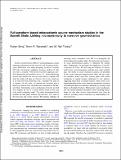Full-waveform based microseismic source mechanism studies in the Barnett Shale: Linking microseismicity to reservoir geomechanics
Author(s)
Song, Fuxian; Warpinski, Norm R.; Toksoz, M. Nafi
DownloadSong-2013-Full-waveform based1.pdf (1.205Mb)
PUBLISHER_POLICY
Publisher Policy
Article is made available in accordance with the publisher's policy and may be subject to US copyright law. Please refer to the publisher's site for terms of use.
Terms of use
Metadata
Show full item recordAbstract
Seismic moment tensors (MTs) of microearthquakes contain important information on the reservoir and fracturing mechanisms. Difficulties arise when attempting to retrieve complete MT with conventional amplitude inversion methods if only one well is available. With the full-waveform approach, near-field information and nondirect waves (i.e., refracted/reflected waves) help stabilize the inversion and retrieve complete MT from the single-well data set. However, for events which are at far field from the monitoring well, a multiple-well data set is required. In this study, we perform the inversion with a dual-array data set from a hydrofracture stimulation in the Barnett Shale. Determining source mechanisms from the inverted MTs requires the use of a source model, which in this case is the tensile earthquake model. The source information derived includes the fault plane solution, slip direction, V[subscript P]/V[subscript S] ratio in the focal area and seismic moment. The primary challenge of extracting source parameters from MT is to distinguish the fracture plane from auxiliary plane. We analyze the microseismicity using geomechanical analysis to determine the fracture plane. Furthermore, we investigate the significance of non-DC components by F-test. We also study the influence of velocity model errors, event mislocations, and data noise using synthetic data. The results of source mechanism analysis are presented for the events with good signal-to-noise ratios and low condition numbers. Some events have fracture planes with similar orientations to natural fractures delineated by core analysis, suggesting reactivation of natural fractures. Other events occur as predominantly tensile events along the unperturbed maximum horizontal principal stress direction, indicating an opening mode failure on hydraulic fractures. Microseismic source mechanisms not only reveal important information about fracturing mechanisms, but also allow fracture characterization away from the wellbore, providing critical constraints for understanding fractured reservoirs.
Date issued
2014-02Department
Massachusetts Institute of Technology. Department of Earth, Atmospheric, and Planetary SciencesJournal
Geophysics
Publisher
Society of Exploration Geophysicists
Citation
Song, Fuxian, Norm R. Warpinski, and M. Nafi Toksoz. “Full-Waveform Based Microseismic Source Mechanism Studies in the Barnett Shale: Linking Microseismicity to Reservoir Geomechanics.” Geophysics 79, no. 2 (March 2014): KS13–KS30. © 2014 Society of Exploration Geophysicists
Version: Final published version
ISSN
0016-8033
1942-2156